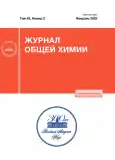Effect of Co-Doping on the Electrical Properties of Magnesium and Copper-Containing Bismuth Niobate with Pyrochlor-Type Structure
- Authors: Piir I.V1, Koroleva M.S1, Maksimov V.S1,2
-
Affiliations:
- Institute of Chemistry, Federal Research Center “Komi Scientific Center of the Ural Branch of the Russian Academy of Sciences”
- Pitirim Sorokin Syktyvkar State University
- Issue: Vol 93, No 2 (2023)
- Pages: 308-313
- Section: Articles
- URL: https://journals.rcsi.science/0044-460X/article/view/145009
- DOI: https://doi.org/10.31857/S0044460X23020178
- EDN: https://elibrary.ru/QCSJDA
- ID: 145009
Cite item
Full Text
Abstract
Keywords
About the authors
I. V Piir
Institute of Chemistry, Federal Research Center “Komi Scientific Center of the Ural Branch of the Russian Academy of Sciences”
Email: ipiir@mail.ru
M. S Koroleva
Institute of Chemistry, Federal Research Center “Komi Scientific Center of the Ural Branch of the Russian Academy of Sciences”
V. S Maksimov
Institute of Chemistry, Federal Research Center “Komi Scientific Center of the Ural Branch of the Russian Academy of Sciences”;Pitirim Sorokin Syktyvkar State University
References
- Subramanian M.A., Aravamudan G., Subba Rao G.V. // Prog. Solid State Chem. 1983. Vol. 15. P. 55. doi: 10.1016/0079-6786(83)90001-8
- Williford R.E., Weber W.J., Devanathan R., Gale J.D. // J. Electroceramics. 1999.Vol. 3. P. 409. doi: 10.1023/A:1009978200528
- D�az-Guill�n J.A., D�az-Guill�n M.R., Padmasree K.P., Fuentes A.F., Santamar�a J., Le�n C. // Solid State Ionics. 2008. Vol. 179. P. 2160. doi: 10.1016/j.ssi.2008.07.015
- Anantharaman A.P., Prasad H. // Ceram. Int.2020. Vol. 47. P. 4367. doi: 10.1016/j.ceramint.2020.10.012
- Gill J.K., Pandey O.P., Singh K. 2012. Vol. 37. P. 3857. doi: 10.1016/j.ijhydene.2011.04.216
- Da Silva S.A., Zanetti S.M. // Ceram. Int. 2009. Vol. 35. P. 2755. doi: 10.1016/j.ceramint.2009.03.022
- Dasin N.A.M., Tan K.B., Khaw C.C., Zainal Z., Lee O.J., Chen S.K. // Mater. Chem. Phys. 2020. Vol. 242. P. 122558. doi: 10.1016/j.matchemphys.2019.122558
- Dasin N.A.M., Tan K.B., Zainal Z., Khaw C.C., Chen S.K. // J. Electroceramics. 2019. Vol. 43. P. 41. doi: 10.1007/s10832-019-00188-1
- Ehora G., Daviero-Minaud S., Steil C., Gengembre L., Fr�re M., Bellayer S., Mentre O. // Chem. Mater. 2008. Vol. 20. P. 7425. doi: 10.1021/cm801942c
- Haas M.K., Cava R.J., Avdeev M., Jorgensen J.D. // Phys. Rev. (B). 2002. Vol. 66. P. 1. doi: 10.1103/PhysRevB.66.094429
- Koroleva M.S., Krasnov A.G., Senyshyn A., Sch�kel A., Shein I.R., Vlasov M.I., Piir I.V. // J. Alloys Compd. 2021. Vol. 858. P. 157742. doi: 10.1016/j.jallcom.2020.157742
- Koroleva M.S., Krasnov A.G., Osinkin D.A., Kellerman D.G., Stoporev A.S., Piir I.V. // Ceram. Int. 2022. doi: 10.1016/j.ceramint.2022.10.290
- Shiratori Y., Tietz F., Buchkremer H.P., St�ver D. // Solid State Ionics. 2003. Vol. 164. P. 27. doi: 10.1016/j.ssi.2003.08.019
- Hector A.L., Wiggin S.B. // J. Solid State Chem. 2004. Vol. 177. P. 139. doi: 10.1016/S0022-4596(03)00378-5
- Shannon R.D. // Acta Crystallogr. (A). 1976. Vol. 32. P. 751. doi: 10.1107/S0567739476001551
- Sadykov V.A., Koroleva M.S., Piir I.V., Chezhina N.V., Korolev D.A., Skriabin P.I., Krasnov A.V., Sadovskaya E.M., Eremeev N.F., Nekipelov S.V., Sivkov V.N. // Solid State Ionics. 2018. Vol. 315. P. 33. doi: 10.1016/j.ssi.2017.12.008
- Krasnov A.G., Kabanov A.A., Kabanova N.A., Piir I.V., Shein I.R. // Solid State Ionics. 2019. Vol. 335. P. 135. doi: 10.1016/j.ssi.2019.02.023
- Pirzada M., Grimes R.W., Minervini L., Maguire J.F., Sickafus K.E. // Solid State Ionics. 2001. Vol. 140. P. 201. doi: 10.1016/S0167-2738(00)00836-5
- Wilde P.J., Catlow C.R.A. // Solid State Ionics. 1998. Vol. 112. P. 173. doi: 10.1016/s0167-2738(98)00190-8
- Rodr�guez-Carvajal J. // Phys. Rev. (B). 1993. Vol. 192. P. 55. doi: 10.1016/0921-4526(93)90108-I
Supplementary files









